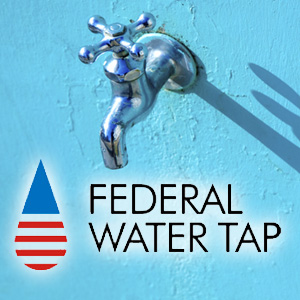Federal Water Tap, November 20: U.S. Government Sets Global Water Priorities
The Rundown
First global water strategy identifies goals and priority countries. The White House asks for $44 billion to assist hurricane rebuilding in Texas, Florida, and the Caribbean. The Senate confirms the first woman to lead the Bureau of Reclamation. The EPA inspector general’s office will investigate the agency’s handling of a $1 billion cleanup of abandoned uranium mines on Navajo land. Two Washington state Republicans introduce a bill to speed up environmental reviews for reservoirs and water supply projects. The House passes a flood insurance bill, while the House and Senate agree on a military spending bill that includes a health study of perfluorinated chemicals. The EPA seeks to delay the Waters of the United States rule. And lastly, the USGS tests whether reservoir sediment could be used as frac sand.
“Safe water and sanitation are fundamental to solving challenges to human health, economic development, and peace and security.” — Passage from the U.S. government’s Global Water Strategy, which was submitted by the Trump administration on November 15 to Congress. The strategy, for coordinating federal government actions to address water issues abroad, was required as part of a 2014 law.
By the Numbers
$44 billion: Additional disaster funding the White House is requesting for hurricane recovery in Florida, Texas, and the Caribbean. Texas Republicans called the proposal “woefully inadequate.” (Office of Management and Budget)
$7 million: Funding for a national study of the effect of perfluorinated compounds on human health. The money was included in a Defense Department spending bill that Congress approved. Perfluorinated compounds, found in foams used to put out oil fires, have contaminated groundwater wells on and near military bases across the country. (National Defense Authorization Act)
294: Underground coal mine sites in West Virginia with water quality measurements in new state data compilation. (U.S. Geological Survey)
News Briefs
Global Water Strategy Submitted to Congress
To coordinate its response to floods, droughts, disease, and other water challenges whose political and economic consequences leap borders the Trump administration submitted the federal government’s first global water strategy.
Ordered by Congress in 2014, the strategy lays out four goals: increase access to safe drinking water and sanitation, improve water management, protect watersheds from pollution, and prevent conflict over rivers, lakes, and aquifers that cross political boundaries.
“The Global Water Strategy represents an important U.S. commitment to solving some of the most severe water crises in the world,” Rep. Ted Poe (R-TX), a co-sponsor of the bill that required the strategy, told Circle of Blue. “Access to water, sanitation, and hygiene not only prevents disease but also improves the safety and security of women and children across the world. It is encouraging to see the U.S. government recognizing water as the global security crises that it is.”
Reclamation’s New Leader
The Senate confirmed Brenda Burman, an Arizona water manager, as commissioner of the Bureau of Reclamation, the agency in charge of dams and canals in the western United States.
Formerly the director of water policy for the Salt River Project, a water and power provider in central Arizona, Burman steps into her leadership role during a time of transition. More dams are being taken down than built, and there is talk of transferring Reclamation assets to local agencies and trying to entice private money into other projects.
Flood Bill Passes House
The House passed the 21st Century Flood Reform Act, which reauthorizes the federal flood insurance program and opens the market to private insurers. The White House has indicated that the president would sign the bill if it gets to his desk.
More ‘Streamlining’ Legislation
Two Washington state Republicans introduced a bill in the House that would speed up the federal permitting process for dams, reservoirs, water supply pipelines, and irrigation projects.
The bill requires environmental reviews to be completed within three years while capping the federal cost at $3 million. The Interior secretary can extend the timeline for up to seven years if he or she determines that a complex project warrants more consideration.
The bill also authorizes four local-federal water projects, the largest of which is the Yakima Basin Plan. Money for the projects would later be made available during the annual budget process.
Studies and Reports
Dredge Reservoirs for Frack Sand?
The U.S. Geological Survey is investigating whether sediment dredged from reservoirs could be used for fracking sand. Selling sand to oil and gas drillers, if viable, would upend the economics of dredging, which typically does not pencil out as a reservoir management strategy.
The test reservoir was Lewis and Clark Lake, a Missouri River impoundment on the Nebraska-South Dakota border. To be used for fracking, sand must have certain properties: round and hard, traits usually found in quartz. After putting the sediment through a battery of tests, the USGS researchers determined that most of the samples met minimum requirements. But the sand was likely not “premium” quality.
Uranium Cleanup Oversight
The EPA inspector general will investigate the agency’s use of a $990-million fund to clean up abandoned uranium mines on Navajo Nation land.
The investigation will examine whether the EPA has an effective cleanup plan for the 50 contaminated sites. The money comes from a 2015 settlement with Tronox, a chemical company, which bought Kerr McGee, the company responsible for the mines.
Food Is Water
What happens if the United States withdraws from NAFTA? The Congressional Research Service looked at the question and found that increased tariffs would reduce the amount of meat, grains, and feed sold to Canada and Mexico. That’s basic economics, but CRS notes that no comprehensive analysis of a NAFTA withdrawal on agricultural markets has been done.
What Is Drought?
CRS, which produces reports for Congress, also recently looked at drought in the United States. Senators and representatives (or, more likely, their staff) will read that drought is not just rainfall; it is a complex hydrological and social phenomenon.
On the Radar
WOTUS Updates
On November 14, the EPA held a “listening session” to get comments from water utilities about changes to the rule. Most commenters wanted to make sure that exemptions for canals, conduits, recharge basins, stormwater systems, and groundwater are maintained.
The EPA and Army Corps, meanwhile, are seeking to delay the effective date of the 2015 WOTUS rule by another two years so that they can rewrite the rule.
Kansas City Revises Sewer Reconstruction Timeline
The water utility for Kansas City, Missouri, and the EPA agreed to a longer timetable for sewer projects required for Clean Water Act compliance. Six projects will take an additional one to two years to complete, which pushes the finish date to between 2018 and 2020.
Federal Water Tap is a weekly digest spotting trends in U.S. government water policy. To get more water news, follow Circle of Blue on Twitter and sign up for our newsletter.
Brett writes about agriculture, energy, infrastructure, and the politics and economics of water in the United States. He also writes the Federal Water Tap, Circle of Blue’s weekly digest of U.S. government water news. He is the winner of two Society of Environmental Journalists reporting awards, one of the top honors in American environmental journalism: first place for explanatory reporting for a series on septic system pollution in the United States(2016) and third place for beat reporting in a small market (2014). He received the Sierra Club’s Distinguished Service Award in 2018. Brett lives in Seattle, where he hikes the mountains and bakes pies. Contact Brett Walton





